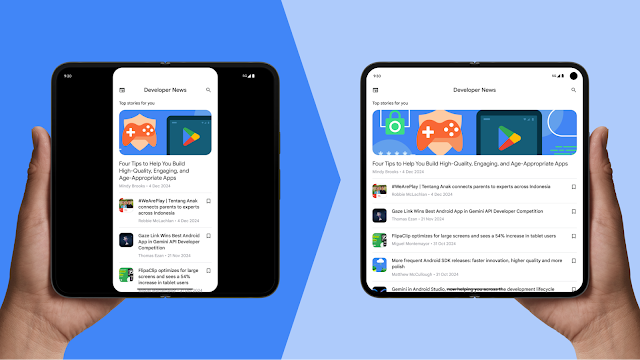Android 应用可在各种设备上运行,包括手机、平板电脑、可折叠设备、ChromeOS 设备、汽车、电视,甚至 XR 设备。为了适应这种多样的环境,您的应用应支持所有设备外形规格和显示大小。
Android 16(API 级别 36)通过替换屏幕方向、宽高比和可调整大小性方面的应用限制,使应用能够适应不同的设备类型和显示屏尺寸。这些替换项适用于最小宽度 >= 600dp 的设备,并定义了以下内容:
- 平板电脑
- 大屏可折叠设备的内部显示屏
- 窗口化模式(适用于所有设备规格)
如果显示屏的最小宽度大于或等于 600dp,以 API 级别 36 为目标平台的应用可调整大小,并且能够进入多窗口模式(相当于 resizeableActivity="true")。

Android 16 强制执行一致的自适应应用设计模型,该模型通过尊重用户对设备方向、宽高比和显示尺寸的偏好来优化用户体验。
变更
对于以 Android 16(API 级别 36)为目标平台且在大屏设备上运行的应用,系统会忽略以下清单属性和 API:
| 属性或 API | 忽略的值 |
|---|---|
screenOrientation |
portrait,landscape,reversePortrait,reverseLandscape,sensorPortrait,sensorLandscape,userPortrait,userLandscape |
resizeableActivity |
全部 |
minAspectRatio |
全部 |
maxAspectRatio |
全部 |
setRequestedOrientation()getRequestedOrientation() |
portrait,landscape,reversePortrait,reverseLandscape,sensorPortrait,sensorLandscape,userPortrait,userLandscape |
异常
Android 16 变更的例外情况包括:
显示屏尺寸小于 sw600dp(大多数手机、可翻转设备和大屏可折叠设备的外屏)
基于
android:appCategory标志的游戏使用 Android App Bundle 和 Play 应用签名发布游戏,让 Google Play 管理该标志并自动提供 app bundle 的优势。另请参阅应用清单概览。
用户在宽高比设置中选择启用应用的默认行为
选择停用
如需停用 API 级别 36 行为,请声明 PROPERTY_COMPAT_ALLOW_RESTRICTED_RESIZABILITY 清单属性。
如需停用特定活动,请在 <activity> 元素中设置相应属性:
<activity ...>
<property
android:name="android.window.PROPERTY_COMPAT_ALLOW_RESTRICTED_RESIZABILITY"
android:value="true" />
...
</activity>
如需为整个应用停用,请在 <application> 元素中设置该属性:
<application ...>
<property
android:name="android.window.PROPERTY_COMPAT_ALLOW_RESTRICTED_RESIZABILITY"
android:value="true" />
...
</application>
测试
如需测试您的应用是否会受到 Android 16 变更的影响,请在 Android Studio 中使用 Pixel Tablet 和 Pixel Fold 系列模拟器,并在应用模块的 build.gradle 文件中设置 targetSdkPreview = "Baklava"。
或者,通过启用 UNIVERSAL_RESIZABLE_BY_DEFAULT 标志,在测试设备上使用应用兼容性框架(请参阅兼容性框架工具)。
您可以使用 Espresso 测试框架和 Jetpack Compose 测试 API 自动执行测试。
常见问题
限制设备屏幕方向、宽高比或应用尺寸调整的应用在 Android 16 上可能会出现显示问题,例如布局重叠。
为了在手机、可折叠设备、平板电脑、ChromeOS 设备、车载显示屏和 XR 设备上提供理想的用户体验,请将应用打造为响应式和自适应:
避免界面组件拉伸:为标准竖屏手机设计的布局可能无法适应其他宽高比。例如,填充整个显示宽度的界面元素在横屏模式下会显得拉伸。为组件添加了最大宽度,以避免拉伸。
启用布局滚动:如果布局不滚动,用户可能无法访问横屏模式下屏幕外的按钮或其他界面元素。启用可滚动应用布局,确保无论显示屏高度如何,所有内容都可触达。
确保相机在纵向和横向模式下均兼容:如果相机取景器预览假定宽高比和方向与相机传感器相关,则在不符合要求的显示屏上可能会导致预览拉伸或翻转。确保取景器可随方向变化正常旋转。 启用取景器以适应与传感器宽高比不同的界面宽高比。
在窗口大小变化期间保留状态:移除屏幕方向和宽高比限制可能会导致应用窗口大小频繁变化,以响应用户使用应用的偏好,例如通过旋转、折叠或展开设备,或者通过在多窗口或桌面窗口模式下调整应用大小。配置更改(例如屏幕方向更改和窗口大小调整)会导致重新创建 activity(默认情况下)。为确保最佳用户体验,请在配置变更期间保留应用状态,以便应用保留数据(例如表单输入),并且用户可以保持上下文。
使用窗口大小类别:无需进行设备专属的自定义设置,即可支持不同的窗口大小和宽高比。假设窗口大小会经常变化。使用窗口大小类别来表征窗口尺寸,然后应用适当的自适应布局。
构建自适应布局:在窗口大小类别中,自适应布局会根据显示屏尺寸的变化进行调整,以始终创建最佳应用呈现效果。
时间轴
Android 16 (2025 年):对于以 API 级别 36 为目标的应用,支持所有屏幕方向和宽高比以及应用可调整大小功能是大屏设备(最小屏幕宽度 >= 600dp)的基本体验。不过,开发者可以选择停用。
2026 年发布的 Android 版本:对于以 API 级别 37 为目标平台的应用,支持所有屏幕方向和宽高比以及应用可调整大小功能将成为大屏设备(最小屏幕宽度 >= 600dp)的基本体验。 开发者将无法选择停用此功能。
| 目标 API 级别 | 适用的设备 | 允许开发者选择不参与 |
|---|---|---|
| 36(Android 16) | 大屏设备(最小屏幕宽度 >= 600dp) | 是 |
| 37(预期) | 大屏设备(最小屏幕宽度 >= 600dp) | 否 |
以特定 API 级别为目标的截止日期因应用商店而异。自 2026 年 8 月起,Google Play 将要求应用以 API 级别 36 为目标平台;自 2027 年 8 月起,Google Play 将要求应用以 API 级别 37 为目标平台。

